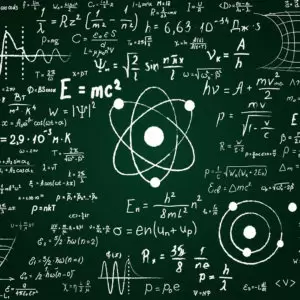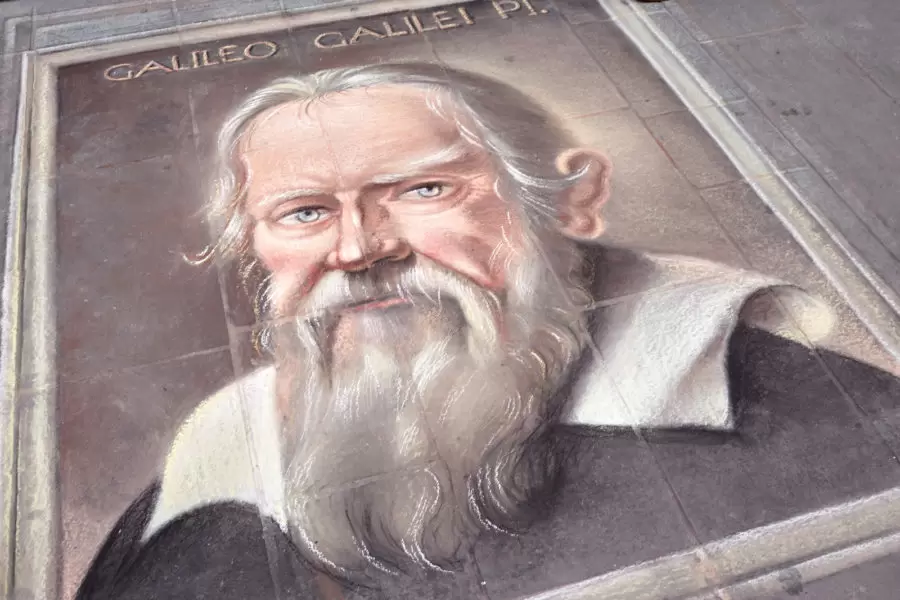
Along with chemistry and biology, physics completes the trinity of the original “hard” sciences - those that use testable predictions and hypotheses, experiments, and mathematics and modelling as opposed to the “soft” sciences which use more qualitative data and which relies far less on testing.
What is Physics?
All of our modern sciences take their names from ancient Greek. In the case of physics, that word is “physik�-” the translated as “knowledge of nature”. Physics, then, means studying nature at its most base level - matter, behavior and motion, energy types, time and space, and their actions and interactions (1). It has gone from an inextricable link with chemistry and biology, and even natural philosophy prior to the Enlightenment to becoming a major force in its own right in the scientific age.
It is the science dedicated to understanding how our world and the universe behaves and why it does what it does. It seems that every time there is a new discovery in physics, it throws up more questions than answers and opens new fields of study. Today, it overlaps with many other sciences and has had a profound impact on the environmental sciences just as chemistry has. It also underpins the physical sciences by providing the theoretical framework on which it may base its own assumptions and basic theoretical models.
Physics is/has:
- Calculated the distance between the Earth and bodies outside of our solar system including other stars within our field of view and other galaxies
- Calculated the age of our sun and how long we can reasonably expect it to keep on burning
- vital for new technologies that all of us use every day from solar panel technology to wind turbine, engineering design, and the creation of new alloys and polymers
- Responsible for nuclear physics which has given us nuclear power, and nuclear medicine which has opened up new avenues of medical treatment for such things as cancer
A History of Physics
In Antiquity: Old and New World
Physics begins with the earliest of civilizations and was limited to astronomy although not as we would understand it today. The ancient Egyptians, Mesopotamians, Greeks and even new world civilizations such as the Maya and Aztec had a complex understanding of the stars. Each of these examined the heavens to track and predict the motion of the sun, the moon and the star field, although largely for the purpose of tracking the seasons and understanding the universe at its simplest level. They did not have the tools or understanding of the heavens to fully understand but in some cases, their mathematics was sound and quite remarkable. Every major civilization had some form of sun worship or veneration and some were surprisingly similar despite a lack of contact (2). For example, ancient Greek myth tells us that Helios the sun god drove a chariot across the sky each night while the Navajo has a remarkably similar belief that their own god Jóhonaa'éí dragged the sun on his back every day (3). All this myth and folklore is, of course, deeply unscientific. But what it did do is lay a foundation for physics by noting - in great detail - how extraterrestrial bodies traversed the sky. There was no explanation for the paths of circles that they made in the sky above us, nor was there any attempt to explain it. But this information was harnessed to track the seasons and plan the ancient agricultural year. Stonehenge in England is considered a giant calendar; the earliest known structures for tracking the movements of the stars throughout the year is in Mesopotamia (4).
Ancient Greek Natural Philosophy
Before physics would become the hard science with all its subdisciplines and subtleties, underpinned by math and underpinning virtually every other science, it would become a way of thinking about the world through natural means. This natural philosophy was of great use to the protoscience. No longer were phenomena considered part of the work of magic or supernatural means. Put simply, natural philosophy determined that every event, no matter the size or significance, must have a natural explanation. This was an important and fundamental shift away from a mystical or supernatural view of the world although it was not based on experimentation or observation as the later science of physics would become. These early thinkers were Thales (5) who created natural philosophy and theorized that seismological events such as earthquakes had a natural cause (correct) but assumed (wrongly) that landmasses were giant rafts that reacted to ocean ripples which caused the quakes.
Thales also theorized that water was the substance on which all matter was built. He was wrong about this too but Anaximander had another idea. He devised something called “Apeiron” matter which has no origin and is limitless and is responsible for creating the universe and everything in it though not by design - that remained the belief of the supernaturalists and mystics (6). This was a philosophical rather than a scientific observation and historians of science today argue repeatedly over what Anaximander's actual meaning may have been. He did not theorize the atom - that would come much later - but some have drawn parallels with the discovery of hydrogen. With Heraclitus, we have the birth of the concept of time as a fluid thing. It wasn't much of a leap for him to determine that nothing ever stayed the same and was subject to constant and infinite change.
But the greatest development in this age, stemming from natural philosophy, was atomism. Although it would take nearly 2,000 years for researchers to discover the atom, the first theory about these tiny particles began in the 5th century BCE during the Greek period (7). Leucippus and Democritus both built on theories from a much earlier time and the writings of ancient Indus Valley and Chinese thought on the matter, but it was during this age that the first true theory was formulated - although without observation. The word “atom” comes from “atomos” meaning “indivisible” as in, they can't be broken down. We now know the idea that atoms cannot be broken down is false.
The Medieval World
For around 1,000 years after the fall of the Western Roman Empire, academic and intellectual pursuits fell out of favor partly due to necessity and partly due to the strict controls placed by the medieval church on things outside the bounds of doctrine. Medieval Europe was a time of little investigation and little interest in all the areas that would today come under the science of physics. However, the church and many other institutions preserved such works out of curiosity if not academic pursuit which is why we know so much about what most Greek and Roman thinkers believed about the world. But the same was not true in the Islamic Middle East. They not only preserved and embraced both western and eastern thinkers but built on their knowledge. It's considered the Islamic Golden Age and many discoveries in the realms of the natural sciences came in this time.

But to say that Christian Europe was intellectually destitute until the Renaissance would be erroneous. Galilei Galileo was one of the world's first astronomers, but his ideas were not completely his own - he had inspiration for the critique of Aristotle's and the ancient world's approach to physics in the form of John Philoponus, a 6th-century Byzantine scholar who questioned many earlier claims. Philoponus is rare in that he based his understanding of the physical world on observation. He influenced later Islamic thinkers (8) before and during the fall of the Eastern Roman Empire (or Byzantium). This Islamic Golden Age was responsible for the beginnings of the Age of Reason. This was the age of optics; Ibn al-Haytham wrote The Book of Optics which saw not only the final nail on the coffin for ancient views about optics but also saw the invention of the Camera Obscura (9). Other optical physicists of this age include Al-Farisi, Al-Kindi (the father of Arab philosophy), Ibn Sahl, and the man considered the greatest ever Islamic scholar - Avicenna - the father of modern medicine but also an astronomer.
The European Renaissance - which many have said was possible due to the flight of Eastern thinkers out of the crumbled civilization of Byzantium and into western Europe, took many of the ancient and more recent works from the Islamic world who had traded their knowledge with the last bastion of the Roman Empire. It would soon be the time for Classical Physics to arise, but the Enlightenment and the modern science was still quite some time away.
Classical Physics
The period of physics and its development from the Renaissance through The Enlightenment and to around the year 1900 is a period known as “Classical Physics”. It's separate from Modern Physics today because it was, in some ways, flawed (10). However, the move to classical physics is noteworthy for the marked shift away from philosophy and intuition-based theory to observation and experimentation. The emergence of optical tools such as the microscope and the telescope allowed the discovery of the atom, the challenge to the notion that the Earth was not just the center of the solar system but the center of the universe, and the identification of gravity. This is the age of Copernicus who defined the heliocentric model of the Solar System, Johannes Kepler who set down laws determining how planetary bodies moved, Galileo whose astounding work in developing telescopes reinforced the Copernican view of the solar system, Isaac Newton who set down universal laws on motion and gravity. Alongside all this were important changes to mathematics. Isaac Newton was also responsible for the invention of calculus (11) which enabled physics to begin to solve some of its most complicated problems.
Changes from the early 19th century that led to the Industrial Revolution were based, in part, on the advanced in engineering that was fueled by advances in physics. Without physics becoming a solid science in the 18th-19th centuries, we may not have had the combustion engine and the use of fossil fuels (12), new developments in metallurgy and building construction and many other things that pushed towards industrialization. It was also the age of electricity and the light bulb - a great age of invention. But despite all this invention and applied physics, classical physics could not explain everything. In fact, it fell down in some complex areas and by the time the 20th century came along, many of its flaws and limitations were already under scrutiny. The ultimate problem was its belief in constants and predictability - understandable in the Age of Enlightenment because science is based on predictability. But physics and the laws that surround it are not unchanging (10). It would take the recognition of these flaws to develop several subfields in the 20th century.
Modern Physics
AS noted above, classical physics, despite its uses, is flawed in several fundamental ways. The 20th century was the beginning of modern physics which would incorporate many discoveries and theories and give birth to some of our most celebrated scientists such as Marie Curie (for her work with radioisotopes), her daughter Irene (who discovered artificial radioactivity), Max Planck (who began developed quantum theory), Vera Rubin (who discovered Dark Matter) Albert Einstein (who revolutionized physics with his Theories of Relativity which solved and corrected a few problems that had bugged various physicists for generations) and Professor Stephen Hawking for a wide range of discoveries, solved paradoxes, and complex theories particularly those relating to the nature of Black Holes (13). This is also the age of space exploration, calculating the size of our solar system and distance to nearest stars and other galaxies. Through mathematical measurements and physics, we have been able to calculate that the size of the visible universe at around 200 billion galaxies. It's even been used to attempt to calculate the potential number of civilizations in the universe. Known as The Drake Equation, it uses mathematical modeling based on what we know about the physical aspects of solar systems, the number of planets, and the relative size of “The Goldilocks Zone”, coming to a conclusion of potentially millions (14).
Quantum Theory gave way to Quantum Mechanics, one of the most complex sciences for the layperson to understand. Its earliest pioneers included Paul Dirac, Werner Heisenberg and Erwin Schrödinger and it remains a complex science today. The early 20th century saw a number of complex experiments in many subfields of physics, none more so than the discovery of the Higgs Boson at CERN's Large Hadron Collider (15), the world's largest particle accelerator. But physics has never been about the complex and lofty - it's also about the everyday. It's at the core of engineering and many other sciences. It's fundamental to the Earth sciences such as meteorology and is vital in our understanding of this generation's most pressing problem - climate change.
Learn How to Become a Physicist >
How Physics Applies to Environmental Science
No other science can get away from physics (or chemistry) because all matter is made up of molecules. As physics is the study of how matter acts and reacts to various forcings and aspects of the world and the universe, physics has massive implications for the environmental sciences.
Climate change: Although few physicists deliberately aim to become climatologists, many today are working on some of the fundamental problems caused by our changing climate and examining potential solutions (16). The physics of our environment, atmosphere and ocean cycle system (18) temperature rises all dictate a number of things such as the fluid movements of water systems such as oceanic oscillations, and how environments will react to atmospheric chemistry changes. Physics will show how climates will change and the long-term effects on both land and aquatic ecologies.
Renewable energy: The contribution of physics to the environmental sciences is no better demonstrated than in the development of renewable energy. For example, solar panels and solar arrays convert light (for panels) and heat (for arrays) into electricity through chemical processes that we have identified through physics (17). Also, physics has been fundamental in developing turbines - the science behind wind farms that also generate electricity. Finally, physics can be used to calculate the amount of energy produced by the processing and burning of biofuel just as it has for fossil fuels.
RELATED: Online Masters in Energy Policy and Climate
Pollution and Human Health: Similar to climate change, physics is key to understanding occurrences and the spread of aerial pollution. This has massive implications for public health and the extent and seriousness of certain conditions, anything from asthma up to lung cancer (18). Physics and physicists measure aerial pollutants, suggest and develop methods of mitigating it, and examines what is an unsafe level. They are also involved alongside chemists in tackling the problem.
Satellite Technology: Without satellites, we would not know as much about our planet as we would have done (16). Physics underpins the rockets used to send satellites into space. Even flight is dependent on physics and the necessary relationship between speed and lift. Secondly, the physics of imagery/photography allows us to take images by capturing light waves and creating the image for environmental scientists to examine, plus the transmission of data from aerial satellites to planet-based computer systems. This goes for thermal imaging and other types that have allowed us to map our world and meteorological events.

Seismology: Understanding physics is also central to predicting and measuring seismological activity - and, of course, preparing for such an environmental disaster as an earthquake or volcano (18). When the ground moves, it creates ripples on the land. Earthquakes that occur at sea create ripples in the water that cause tsunamis. One of the worst seismological disasters of the modern age happened at Christmas 2004 when an earthquake under the ocean causes a massive tsunami, killing around 250,000 people. Physics can predict, based on the size of seismological activity, the impact on land and ocean of such activity.
The Sub-Disciplines of Physics
As with the other hard sciences, physics can be broken down into two broad groups - applied physics and theoretical physics. The latter is concerned with devising theories about how the universe or any atoms or molecules within it might function. Applied physics is the practical use of materials, typically used in engineering projects. With each new discovery, new science and new technology, there will always be issues for physics to understand and deconstruct.
Acoustics
The science of sound and the study of sound waves is known as “acoustics” (19). This is both a theoretical and an applied science. It's important n concert halls and theaters, for example, to design the architecture so that it makes the best use of the sound, make it carry far, and channel noise without too much feedback or echo. It's been used to great effect in modern churches too for the same reason. Although invisible, sound occurs as waves, spanning out from a central point. They are the reverberating of aerial particles reacting to sound. It is not just about music or architectural use either. The science of acoustics also includes other aspects of sound engineering - the creation of sound and control of sound (reduction). Other uses include SONAR - used by civilian and military shipping to detect anomalies at and under the sea, medical use with ultrasound scanning, and even seismology.
Astronomy
Astronomy is one of the oldest forms of modern physics and existed long before physics was even a science. For most of recorded history and even before that, humans have been interested in the stars, their relative positions, and using them to track the seasons. The stars and planets inspired imagination and are at the center of some of our most enduring myths. But astronomy today is very different. It is the study of objects in the sky (moons, planets, comets, asteroids, stars, galaxies, black holes) - their movement and motion, position relative to our own planet, star or galaxy, chemistry and makeup, and mathematical principles. It was once tied to astrology but today this is mysticism and despite looking at positions of astrological bodies, there is no science to it (20).
Astrophysics
Often used interchangeably with astronomy, there are several key differences between astronomy and astrophysics although experts in the two groups very often work together on the same projects. The main difference between astronomy and astrophysics is that the former concerns measurements, distances, movement and relationships. The latter used physical principles and mathematical measurements to understand those relationships - attraction and repellence, gravity, combustion within stars and other physical principles (21). However, astrophysicists need to understand astronomy to work out why extraterrestrial bodies have such relationships and astronomers use data from astrophysics to predict or plot paths.
Atomic Physics
Atoms form all matter - organic and inorganic and are the building blocks of material across the known universe. Therefore, the work of atomic physics is to study atoms (22). They will look at such elements as the number of electrons, how they change in response to stimuli, and the structure of the electron cloud. Although many people who work in this field are considered to be concerned with nuclear power generation and nuclear weapons, that is too narrow and simple a view of atomic physics; nuclear physics is one area of atomic physics and in many ways quite separate from it. In more recent decades, it has forged stronger links with quantum mechanics as the research there has developed and shown further applications.
Biophysics
Physical sciences use math to understand and explain nature whereas biological sciences want to understand how a biological system will function. These are overlapping areas and biophysics is the branch designed to bridge the gap between biology and physics, it is a theoretical framework and an applied science that uses physics to understand biological systems. A typical example is understanding physical mechanics of how a molecule is created, the various parts of a cell or organism work in a physical level, including the neurological system including electrical impulses transmitted between the brain and organs, immune system, and other structures. It uses principles from math and chemistry as well as biology and physics (23).
Chaos Theory
This is an area of physics and mathematics that examines behavior of systems (24), their sensitivity to even minor change, and how they react to that change. It is a cross-disciplinary theoretical approach that may apply to almost any other science. Its core philosophy is that in spite of apparent randomness, there are systems in place, and patterns, that keep equilibrium. Any change, no matter how small, can affect the whole in profound ways - this is called The Butterfly Effect, the idea that a butterfly flapping its wings in one geographical location can cause weather systems to begin on the other side of the planet. The theory can allow us to predict weather patterns but is also the main reason why meteorologists can get it so wrong - minor fluctuations can change the direction of a weather front.

Chemical Physics
There are more links between physics and chemistry than atoms. Chemical physics fuses both sciences and incorporates such mutual areas as atomics, molecular physics and solid state chemistry. This is an umbrella term for anything with a mutual interest in chemistry and physics but does not include physical chemistry which is a related but slightly different subdiscipline and more a branch of chemistry than physics. Chemical physics studies the chemical reactions of substances through applied atomic physics. It's interested in of electrons, nuclei, and atoms and molecules. Physical chemistry examines the physical nature of chemistry and chemical molecules and compounds.
Computational Physics
Related to mathematical physics, computational physics is the use of powerful mathematical and other models to test physics and other theories with a physical angle. This is one of the oldest subdisciplines of physics that uses information technology (25). Many have argued whether it is theoretical or applied as it takes theories and tests them. However, it is also a practical use in collecting data from physical sources. The SETI program uses computational physics looking for signs of extraterrestrial life, filtering out natural background noise. The event known as “The Wow Signal” used computational gathering and filtering to great effect (26). Sadly, it has never been replicated and although our best chance of discovering extraterrestrial life will require powerful computing, we have not achieved it yet.
Cosmology
Arguably, this is the discipline that physics was before it became physics the science. Cosmology is related to astronomy and astrophysics but instead of looking at mathematical probabilities, physical structure, motions, relationships, gravity et al, it looks at all of this data for evidence of the formation of the universe, tracing its evolutionary history back to the Big Bang and those precious few seconds after the universe's formation. It also seeks to work out when the universe will end and what will happen next. Simply, it is the study of the universe on the largest possible scale. This is the area of physics and astronomy concerned with string and superstring theory, dark matter and energy, and the theories concerning the possibility of the multiverse (27).
Cryophysics/Cryogenics
Temperature is an important influence of physical material. Liquid matter turns solid when cold enough and to gas when hot enough. The simple physical effect is the slowing down and compacting of physical material. Cryophysics and cryogenics go beyond merely the study of temperature - it is an examination of the effects of extremely low temperatures, typically working in the Kelvin scale rather than Celsius or Fahrenheit. In popular science, cryogenics is the belief that the human body can be reduced to these temperatures artificially to preserve organic material and prevent natural decomposition. But cryophysics and cryogenics are about far more than the preservation of organic matter - it is about studying properties and effects on both organic and inorganic matter.
Crystallography
Crystalline solids have an interesting molecular bonding that differs from all other matter. While the analysis of the structure of the physical material is not unique in crystallography, how such materials as diamond functions and fits together can help us understand other matter (28). The science grew as a result of the discovery of laser and its many industrial, research, and medical applications. It has many applications today in biomedical research, chemistry, physics, but also in areas we never perceived such as genetics and the treatment of diseases such as cancer, all because we can manufacture tools with precision and use the unique structure of crystals.
Econophysics
If two sciences were never supposed to go together, those branches would be physics and economics. Yet both use mathematics at their core. Econophysics is the use of physical principles, particularly those that are mathematical in nature including statistics (29), statistical probability, stochastic processes (probability and randomness) and even chaos theory (see above) as applied to unpredictable problems. In fact, the use of physics and a modeling system goes back to the birth of classical liberalism and that method of economics that rose around the Industrial Revolution. It allows for a non-static system in economics, one subject to irrational thoughts and actions on the part of the elements (i.e. people) and their ability to affect demand and price.
Electronics
“Electronics” in the 21st century tends to refer to devices such as televisions and smartphones. The science of electronics is not the actual devices, but the science that makes them possible. This is a subdiscipline of physics that examines all elements of the development of devices that use electricity, but it also looks at the properties of electrons when operating in a vacuum, through gases, or the effect and impact of conducting material. It is concerned with elements of an electronic device including data transmission and storage, heat, transistors, LEDs and other diodes, circuits and circuit boards, and technologies designed to connect to them. The main challenge of electronics at present is to continue to increase in functionality while reducing power consumption.
Electromagnetism
This subarea of physics examines electromagnetic force. This is an interaction that takes place between electrically charged particles, creating electromagnetic, electrical and magnetic fields and light. These are one of the four broad “forces” in the physical world (30). Electromagnetism can manifest itself in many ways with lightning being one of the most common, but it is not the only example. Electromagnetism is vital for both organic and inorganic objects and their functions. Electricity and magnetism were long considered two separate but complementary forces, but we know now that they are related and part of the same thing, hence why this subdiscipline is required - to study the causes and effects of electromagnetism in everyday use.

Fluid Mechanics
Fluid mechanics is an applied area of physics that concerns the motions and properties of substances in a fluid state - plasmas, liquids, and gases. It is broken down into two areas: fluid dynamics and fluid statics. Fluid dynamics is not limited to physics but is included in any science that has a professional interest in the motion of the fluids listed here. Typical applications include examining star formation (astronomy), ocean oscillations and forcings (meteorology and environmental science), how wind turbines function and can harness wind power (environmental engineering), seismological activity. It even has medical applications in studying the functions of blood within the circulatory system (31). Fluid statics is the examination of fluidic substances when they are not in motion.
Geophysics
Part environmental science, part engineering, and part physics, geophysics has massive implications and uses elsewhere. It's used in archaeology, anthropology, geology and paleontology to discover buried remains. It's used to create maps of features over small and large areas. But at its core, geophysics is the characterization of topography and subsurface features as a physical geography, their physical attributes and effects, based on 3D models (32). The technology may not have many uses for applied physics, but it has broad and potentially limitless uses elsewhere. But how does it work? It measures the Earth's shape, magnetic and gravitational fields, geological composition, topographical features and structures, and all associated dynamics. Although it looks for hard buried remains as anomalies, it can also be used to examine the water cycle.
Laser Physics
Laser physics, also known as laser science (33), is the study of the activities, applications, attributes and nature of lasers. A laser (light amplification by stimulated emission of radiation) is an intense beam of electromagnetic light of a single wavelength or spectrum color, It utilizes quantum electronics and optical cavity design as well as designing technology and media to use laser (for example, Blu Ray discs that use a blue laser to read the data stored on it). There is also industrial uses such as laser precision cutting, and medical uses such as soft tissue destruction; more recently is laser eye surgery used to correct defective vision.
Mathematical Physics
This is one of the theoretical areas of physics that looks towards applied mathematics to solve some of the biggest conundrums and problems that exist in physics (34) but also applied research that uses math as a major tool. Some of the issues that have utilized mathematical physics include calculating the size of our galaxy by pinpointing the stars within it and working out distances. Questions concerning the search for extraterrestrial life has come up with “The Drake Equation” (a mathematical model) which looks at the possibility of intelligent life existing on other plants. It has fueled interest in the field and drive the SETI program. There are also used in statistical probability,
Mechanics
Also known as “classical mechanics” this is an explanation of how objects move - both artificial and natural. Therefore, it concerns the motion and gravitational effects of stars on planets but also studying the motion of aircraft, machinery, individual parts, and anything else that moves (35). When an object is understood, it is possible to predict its future and past movements. It is as much math as it is physics and is largely credited to Sir Isaac Newton who identified the possibility of movement of objects based on force. But it remains relevant today in aerospace engineering amongst other things; the reason it was given a new name was due to its limitations elsewhere and new branches of science that developed in the wake of Einstein's later equations.
Medical Physics
Medical science is a multidisciplinary approach, one of the most important sciences in the world today, and one of the areas that have benefited most from medical applications. Medical physics is any application of physics to the medical world. This can include nuclear medicine in the treatment of cancers and other growths, ultrasound to perform scans of body interiors to measure tumors or check on the progress of a fetus, radiology such as x-rays, and utilizing both theory and practical physics (36). It can also be used to design and implement new medical technologies for treatment and scanning.
Meteorology
Although largely an Earth Science, meteorology is built on a strong foundation of physical principles. Weather systems, weather fronts, and the phenomena that result are all caused by the physical movement of the planet which in turn affects tide, wind direction, speed, pressure and all other elements that lead to certain weather phenomena (37). It is also important for plotting and predicting the effects of climate change. Chemical imbalances, water levels, oscillations and movement of air and water may all have a profound effect on meteorological events - everyday weather, but also extreme precipitation (droughts and flooding), heatwaves, cold spells and so on.
Molecular Physics
The study of the physical properties of molecules (which are made up of atoms), the chemical bonds between atoms that create molecules, and molecular dynamics is known as “molecular physics” (38). It has a close relationship with several areas of chemistry, but also other areas of physics as molecules underpin many things about the physical world. It examines the interactions between molecules and how bonds are forged and broken. It us fundamental to understanding the most basic processes of the universe and the abundance of elements.
Nanotechnology/Nanophysics
This is the science and engineering development of the extremely small - objects that could only be seen under a microscope (39). Although an engineering “problem” or technological advance to solve, the potential of microscopic machines will need to utilize physics and physical properties of devices to deliver new medical technologies, work in dangerous environments such as handling chemicals, environmental remediation and a variety of other areas. The science concerns the ability to control individual atoms as well as create and control small machines. It is believed that manipulating individual atoms may provide the keys to unlocking the universe and be the next big step in the evolution of physics as a science.

Nuclear Physics
Nuclear physics conjures up ideas of nuclear bombs and nuclear power, but it is much simpler than that. Atomic physics deals with the physics of atoms including each atom's electrons, but those who work in nuclear physics study only the nuclei of atoms, their makeup, and how they act and react (40). It is the pursuit to split the atom and harness its energy that has led to nuclear technologies - the bomb and power, but also nuclear medicine and magnetic resonance imagery (MRIs) all of which harness nuclear technology in varying ways. It has also allowed radiocarbon dating, agricultural isotopes, and developments in engineering and chemistry. It is expected to deliver future developments in transportation and energy production as the world moves away from oil.
Optics
Also known as “light physics”, optics is the study of the properties, origins, actions and interactions of light and its associated particles. Light has no mass (41) as it is made up of photons which have no mass. Yet they have energy and momentum. The speed of light is presently known to be the fastest possible speed although science fiction writers and physicists alike have argued for decades over whether it would be possible to travel faster than this. It is also the study of sight because it is light penetrating our eyes interpreting the light patterns that allow animals that can see to do so.
Particle Physics
Closely related to nuclear physics (see above) from which it evolved, particle physics differs in that it is the study of the effects, matter, and radiation, of all particles not just atomic nuclei. This includes the smallest of all particles, far smaller than the atom, such as quarks, leptons, photons and so on. Modern particle physics examines the “Standard Model” of fundamental particles and fields as well as the newer recent particles such as the Higgs boson discovered in the early part of this decade at CERN (42).
Photonics
Although some scholars include photonics within the subdiscipline of optics (the physics of light - see above), others argue that photonics is a slightly different discipline. Depending on who you ask, it can mean the application of light while optics is the theory. Others perceive the difference as one of classical physics (optics) and quantum physics (for Photonics) which would make photonics a subdiscipline with optics as a sub-subdiscipline. There is, however, no agreed terminology and the two may be used interchangeably (43).
Plasma Physics
In physics, there are four states of materials - gas, liquid, and solid are the three most commonly known outside of science, but the fourth is plasma (44). Unlike the other three, the variable for creating it is not the temperature - it is the addition of energy to disrupt the electrons and charge them negatively (called ionization). It also gives plasma new properties; it will demonstrate strong reactions to electrical and magnetic interference. Plasma is naturally occurring and according to research, may represent as much as 99% of all material in the universe. Plasma physics is the study of plasma, its properties and actions under certain pressure.
Quantum Physics
An umbrella term for everything relating to the quantum rather than the classical physics - that is anything concerning the smallest particles, much smaller than atoms. It is a broad branch that covers the following fields.
Quantum Electrodynamics
A cousin of classical electrodynamics (45), quantum electrodynamics (or QED for short) explains the interactions between matter and light. It also happens to be the first quantum theory where there is a universal agreement between special relativity and quantum mechanics. It describes, mathematically, the phenomena and interactions associated with electrically-charged particles and their photon exchange. It essentially visualizes this exchange as a force - enter, exchange, and emerge, as described by Richard Feynman in one of his many diagrams.
Quantum Gravity
Gravity is and has been one of the most complex theories to puzzle physicists. Quantum gravity is a theoretical framework based on the principles of quantum mechanics. It is primarily concerned with astrophysics and the strong gravitational effects of extraterrestrial bodies on each other.
Quantum Field Theory
This is an area of theoretical physics in which researchers construct models for the quantum mechanical models for subatomic particles for the area of particle physics and does the same for quasiparticles for the area of condensed matter physics (46). It is a framework, a set of theories and mathematical models and tools integrating special relativity, classical physics, and aspects of quantum mechanics. It is an effective field theory today but was once considered “fundamental”, the downgrade being certain failures within general relativity.
Quantum Optics
Today, optics is one of the best areas for exploring quantum mechanics (47) through both classical and quantum theories. It concerns the quantum aspects of light - action and interaction, light detection and its properties through the study and theory of photons.
Solid State Physics
While fluid dynamics is concerned with fluid matter (liquid, gas, plasma), solid state is about materials in a solid form. It applies both classical and quantum physics, crystallography as crystals are one of the most interesting sold substances (see above), and many other subareas. It examines how properties of solid materials on the larger-scale are caused by atomic-scale properties and is a multidisciplinary science that fuses physics with materials science - working on such mutual interests as resistance and conduction (48).
Thermodynamics
Best known for their laws, thermodynamics concerns the relationship between applications of heat and energy. Specifically, it looks at how energy is created from temperature, and its attributes and applications. Energy is created or altered when heat applies to something (49). For example, boiling a pan or kettle increases the movement speed of the water until it reaches what we call “the boiling point”. Once this happens, the liquid water becomes a vapor as the applied temperature increase breaks the bonds between the molecules. It also concerns heat and energy transfer, entropy (the waste heat leading to a loss of energy from a closed system), the Carnot Cycle and the law of cooling. There are four laws of thermodynamics which are:
- The Zeroth Law: when two bodies have thermal equilibrium with a third body, the result is that they are in equilibrium with each other
- The First Law: Increase in a system's energy equals the increase in thermal energy; additional is the work done on the system
- The Second Law: Heat energy cannot transfer from a lower temperature to a higher temperature body without additional energy
- The Third Law: The entropy (waste energy) is zero in a crystal at absolute zero temperature
Future Challenges and Opportunities for Physics
There will always be the need for physics as it is so important to all other sciences - chemistry, biology, technology, engineering and so on. While some sciences argue over whether they have reached the limits of the questions they can ask, physics only presents more questions with every answer. These are the future challenges for physics.
What is the True Size of the Universe?
Our galaxy is some 100,000 light years across. We are just one of around 2 trillion known galaxies (50) in the observable universe, only a small fraction of which we can presently observe. The “observable” part is what is important here - beyond that, we do not know how many more galaxies exist. We have been able to see these galaxies through optics and measuring light waves. What happens beyond that range? If we can “only” see 2 trillion by putting our galaxy at the center of that narrow band, we have to ask how much more of the universe we cannot see because the light waves from these galaxies have yet to reach us and may not do so for thousands or even millions of years.
Understanding the Sun
The star at the heart of our solar system remains - in many ways - quite enigmatic. We can say with confidence that it is approximately halfway through its life. We also know its eventual fate based on the actions of similar observed stars in the universe. But there is still so much about it that we don't understand - for example, the properties and speeds of solar winds for which conventional thermal models are inadequate, and the true limit of the heliosphere, and its effects on “space weather” (51).
SETI
This is the “Search for Extraterrestrial Intelligence”. With so many galaxies, it stands to reason that life will have evolved elsewhere. But this could ultimately prove a futile search as we could be alone - for now, or we could be the only civilization for now in a universe teeming with simple life. Civilizations may have come and gone in the billions of years of this universe and some may evolve way after we are gone. We have observed a tiny fraction of the observable universe with no compelling evidence that civilized life exists anywhere close, although “The Wow Signal” is the only signal we have ever received, it may just have a naturalistic explanation if it is ever found a second time. Justifying this expense is a matter for all sciences to come together and demonstrate its worth for the good of all humanity, rather than the perception that it is a frivolous waste of money.

Climate Change Mitigation
This will require forging stronger links with climatology and other environmental sciences, but climate change mitigation is a challenge that affects us all. It is through atmospheric physics that we come to predict and model the effects of climate change and it is to physics people who work in this area who may yet provide part of the solution (52). But there is still much we do not understand about atmospheric concentrations and the relationship with weather patterns. The answers should come through a combination of physics and chemistry and applications of chaos theory.
Energy Needs vs Cleaner, Greener Technologies
A growing population requires more energy needs, but the needs of climate change mitigation mean we must do everything we can to reduce our energy consumption. There may seem to be a conflict, and there is to a certain degree, but advances are already being made through applied physics. Batteries, power cells and other energy storage methods are able to store more power than ever before, while our electronic devices get more powerful every day will reducing power consumption. In future, we expect new advances in physics and chemistry to reduce energy consumption further still (17) - from LEDs that emit powerful lights at much lower consumption, but also more efficient solar paneling and electrical vehicles. Physics has helped meteorology and climatology to develop wind turbines, solar physics to develop solar arrays and paneling, and harnessed water physics to develop tidal power, hydroelectricity and other water-based technologies that harness energy from the movement of fluid. It has also developed nuclear power; what new technologies lie for the remainder of the 21st century will only build on our growing energy needs for a growing population.
The Internet
The big stories at the moment as far as the web is concerned are cloud storage, big data, and the “internet of things”. The internet is an invention of physics - the transmission of data through the radio and other waves, from one device to another, over the airwaves utilize some of the oldest and most commonly understood of all physics-based technologies. The challenge though is to continue to drive forward technologies for increasingly faster web access, easier connectivity of new devices, to ensure that connectivity isn't limited by the number of people trying to access it and to provide the technology that will continue to deliver enough storage to hold that data in the cloud. All the while, it is down to physics to ensure that we're doing all we can to deliver this while driving down energy consumption.
Learn How to Become a Physicist >
Sources
- https://www.britannica.com/topic/sun-worship
- http://blog.nmai.si.edu/main/2017/08/indian-beliefs-eclipse.html
- https://www.researchgate.net/publication/259712780_Calendars_and_Years_Astronomy_and_Time_in_the_Ancient_Near_East_edited_by_John_M_Steele
- http://galileoandeinstein.physics.virginia.edu/lectures/thales.html
- https://explorable.com/ancient-physics
- https://www.britannica.com/topic/atomism
- https://plato.stanford.edu/entries/philoponus/
- http://journals.sagepub.com/doi/abs/10.1068/p3210
- https://iopscience.iop.org/book/978-0-7503-1206-6/chapter/bk978-0-7503-1206-6ch1
- https://www.math.uh.edu/~tomforde/calchistory.html
- http://resources.schoolscience.co.uk/IoP/14-16/biogs/biogs5.html
- https://www.newscientist.com/article/2053929-a-brief-history-of-stephen-hawking-a-legacy-of-paradox/
- https://www.seti.org/drake-equation-index
- https://www.smithsonianmag.com/science-nature/how-the-higgs-boson-was-found-4723520/
- https://arxiv.org/ftp/physics/papers/0501/0501021.pdf
- https://www.nap.edu/read/10118/chapter/10
- https://acoustics.byu.edu/what-is
- http://articles.adsabs.harvard.edu/cgi-bin/nph-iarticle_query?db_key=AST&bibcode=2012JAHH...15...42L&letter=.&classic=YES&defaultprint=YES&whole_paper=YES&page=42&epage=42&send=Send+PDF&filetype=.pdf
- http://curious.astro.cornell.edu/about-us/145-people-in-astronomy/careers-in-astronomy/general-questions/892-what-s-the-difference-between-astronomy-and-astrophysics-intermediate
- http://users.aber.ac.uk/ruw/teach/327/atomic.php
- https://www.biophysics.org/what-is-biophysics
- https://geoffboeing.com/2015/03/chaos-theory-logistic-map/
- https://www.wiley.com/en-us/Computational+Physics%3A+Problem+Solving+with+Python%2C+3rd+Edition-p-9783527413157
- https://www.nrao.edu/archives/items/show/3684
- https://www.space.com/16042-cosmology.html
- http://www.xtal.iqfr.csic.es/Cristalografia/index-en.html
- https://www.researchgate.net/publication/265875318_What_is_EconoPhysics
- http://hyperphysics.phy-astr.gsu.edu/hbase/Forces/funfor.html
- https://www.livescience.com/47446-fluid-dynamics.html
- http://www.eegs.org/what-is-geophysics-
- http://www.iop.org/cs/page_43644.html
- https://www.livescience.com/47814-classical-mechanics.html
- https://medicalphysics.duke.edu/medical_physics
- https://www.nature.com/articles/130708a0
- https://jila.colorado.edu/research/atomic-molecular-physics
- https://www.nano.gov/nanotech-101/what/definition
- http://www.desy.de/user/projects/Physics/Relativity/SR/light_mass.html
- https://home.cern/topics/higgs-boson
- http://optics.org/article/32348
- http://www.plasmas.org/basics.htm
- http://hyperphysics.phy-astr.gsu.edu/hbase/Forces/qed.html
- https://plato.stanford.edu/entries/quantum-field-theory/
- http://gerdbreitenbach.de/gallery/
- http://www.physics.udel.edu/~bnikolic/teaching/phys624/lectures/what_is_solid_state_physics.pdf
- https://www.livescience.com/50776-thermodynamics.html
- https://iopscience.iop.org/article/10.3847/0004-637X/830/2/83
- https://www.frontiersin.org/articles/10.3389/fphy.2013.00006/full
- https://www.aps.org/policy/reports/popa-reports/energy/climate.cfm
- Guide to Parasitology - November 19, 2018
- Deserts as Ecosystems and Why They Need Protecting - November 19, 2018
- Conservation: History and Future - September 14, 2018
Related Articles
Featured Article

Geospatial Technology: An Introduction and Overview





